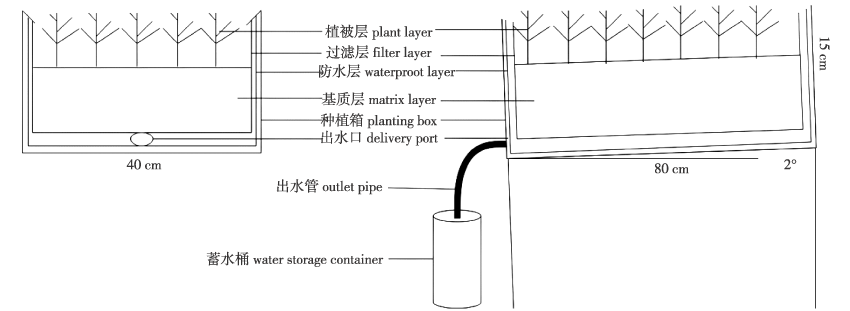 PDF(2010 KB)
PDF(2010 KB)


Effect of biochar application on soil runoff and water quality in green roof
LI Juan, XUE Jianhui, XIONG Weiwei, ZHANG Guowei, WANG Hankun
JOURNAL OF NANJING FORESTRY UNIVERSITY ›› 2025, Vol. 49 ›› Issue (2) : 153-160.
 PDF(2010 KB)
PDF(2010 KB)
 PDF(2010 KB)
PDF(2010 KB)
Effect of biochar application on soil runoff and water quality in green roof
【Objective】Roof greening has become a popular method for increasing urban green spaces and mitigating the urban “heat island effect”. Recently, biochar, known for its lightweight and highly porous nature, has been utilized as a soil amendment in the agricultural and forestry sectors. This study explores the impacts of varying biochar application rates and pyrolysis temperatures on soil runoff and nutrient content in roof greening, to assess biochar’s potential for enhancing urban roof greening practices.【Method】The experiment involved three levels of biochar application (0%, 10% and 20%, volume fraction) and three pyrolysis temperatures (300, 400 and 500 ℃), with four replicates per treatment. Each planting box was filled with a 10 cm thick layer of treated soil matrix and planted with Sedum lineare. Soil runoff was collected and analyzed after each rainfall event.【Result】The findings indicated that biochar application could increase soil pH and significantly reduce the levels of total nitrogen (TN) and dissolved organic carbon (DOC) in the runoff. While a 10% biochar addition decreased the total phosphorus (TP) concentration in the runoff, a 20% addition had the opposite effect. Moreover, biochar was effective in reducing soil runoff and nutrient concentration, thus minimizing nutrient loss from the soil. There was no significant difference in the effects of biochar processed at different pyrolysis temperatures on runoff quality. 【Conclusion】Optimal biochar application can significantly decrease N and P loss in roof soil runoff, indirectly reducing urban runoff pollution. This suggests a promising application for biochar in managing urban stormwater runoff.

roof greening / biochar / addition amount / pyrolysis temperature / soil / runoff water quality / urban pollution
| [1] |
董菁, 左进, 吝涛, 等. 高度城市化地区屋顶绿化径流调控效益评价:以厦门岛为例[J]. 生态学报, 2022, 42(6):2237-2250.
|
| [2] |
|
| [3] |
陈智龙, 董雨琴, 陈凌静, 等. 城市热岛效应变化及其影响因素分析研究[J]. 江苏林业科技, 2021, 48(6):34-40,52.
|
| [4] |
|
| [5] |
|
| [6] |
|
| [7] |
|
| [8] |
|
| [9] |
|
| [10] |
|
| [11] |
|
| [12] |
张鹏. 屋顶绿化专用草坪草筛选研究:以济南地区为例[D]. 济南: 山东建筑大学, 2021.
|
| [13] |
|
| [14] |
|
| [15] |
陈颢明. 屋顶绿化基质中添加生物炭的生态效应研究[D]. 南京: 南京农业大学, 2018.
|
| [16] |
|
| [17] |
周之栋, 卜晓莉, 吴永波, 等. 生物炭对土壤微生物特性影响的研究进展[J]. 南京林业大学学报(自然科学版), 2016, 40(6):1-8.
|
| [18] |
王娟, 黄成真. 生物炭对土壤改良效果的研究进展[J]. 水资源与水工程学报, 2020, 31(3):246-253.
|
| [19] |
黄康. 不同热解温度秸秆生物炭还田培肥土壤及其固碳潜力的研究[D]. 武汉: 华中农业大学, 2022.
|
| [20] |
丁应祥. 下蜀森林生态定位站径流场土壤性状及分类[J]. 南京林业大学学报, 1999, 23(6):37-42.
|
| [21] |
国家环保局《水和废水监测分析法》编委会. 水和废水监测分析方法[M]. 4版. 北京: 中国环境科学出版社, 2002: 236-284.
Editorial Committee of The Water and Wastewater Monitoring and Analysis Law of the National Environmental Protection Administration. Water and wastewater monitoring and analysis methods[M]. Fourth Edition. Beijing: China Environmental Science Press, 2002: 236-284.
|
| [22] |
生态环境部.环境影响评价技术导则地表水环境:HJ 2.3—2018[S]. 北京: 中国环境科学出版社, 2018.
|
| [23] |
国家环境保护总局,国家质量监督检验检疫总局.地表水环境质量标准:GB 3838—2002[S]. 北京: 中国环境科学出版社, 2002.
|
| [24] |
刘楠. 缙云山典型林分对径流水质的作用及评价研究[D]. 北京: 北京林业大学, 2011.
|
| [25] |
罗婷, 许文年, 程虎, 等. 粗放型绿色屋顶基质层对降雨出流水质影响[J]. 环境工程, 2020, 38(4):39-45.
|
| [26] |
|
| [27] |
戴子云, 谢军飞, 许蕊. 北京地区绿色屋顶的径流特征研究[J]. 建筑节能(中英文), 2022, 50(5):99-104.
|
| [28] |
张千千, 王慧玮, 翟天伦. 绿色屋面基质添加生物炭对降雨径流水质和水量的影响[J]. 生态环境学报, 2017, 26(6):1026-1033.
|
| [29] |
|
| [30] |
|
| [31] |
|
| [32] |
|
| [33] |
|
| [34] |
闫代红, 马亚培, 宋凯悦, 等. 原料和热解温度对生物炭中可溶性有机质的影响[J]. 环境科学, 2021, 42(10):5030-5036.
|
| [35] |
丁思惠, 方升佐, 田野, 等. 不同热解温度下杨树各组分生物质炭的理化特性分析与评价[J]. 南京林业大学学报(自然科学版), 2020, 44(6):193-200.
|
| [36] |
|
| [37] |
|
| [38] |
孙涛, 朱新萍, 李典鹏, 等. 不同原料生物炭理化性质的对比分析[J]. 农业资源与环境学报, 2017, 34(6):543-549.
|
| [39] |
|
/
| 〈 |
|
〉 |